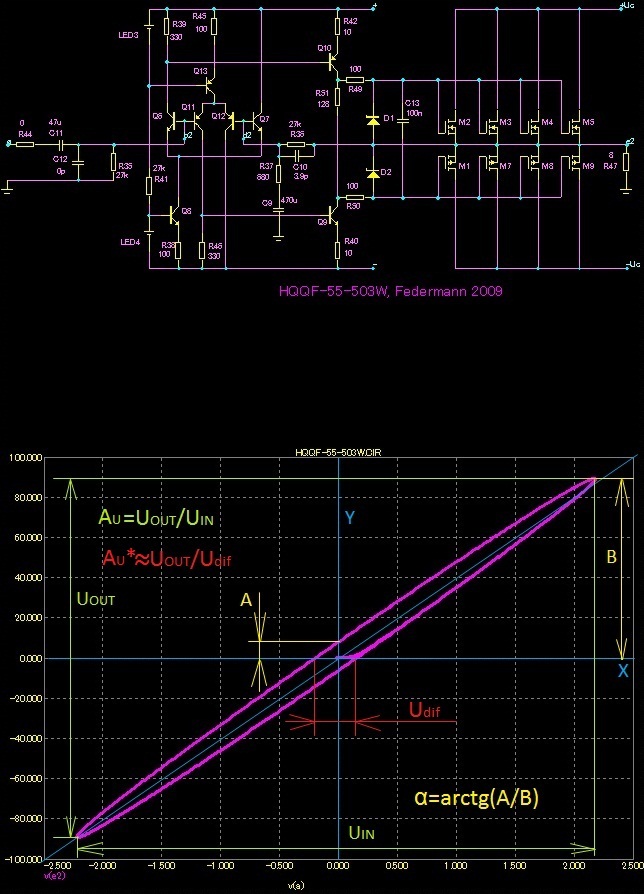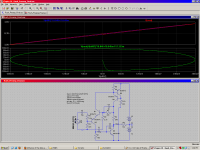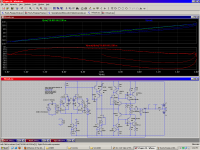"Never, repeat never, to me does not make that model did not fit the facts, must I know what I choose and in the production account."
If I said model an OPA604 set up for a gain of 10 and show me the square wave response at 10 volts pk pk @ 50 khz, and I went and built that circuit on a sensible PCB I guarantee the real world result would be different.
If I said model an OPA604 set up for a gain of 10 and show me the square wave response at 10 volts pk pk @ 50 khz, and I went and built that circuit on a sensible PCB I guarantee the real world result would be different.
If you have zero practical experiences, how do you can to add all into model ? And by your design I really see, that your experiences with mosfets are near zero, sorry...
Again, let's ask for real amplifiers, real experience, real parameters and/or listening tests. Am I to quote builders of the previous version??
Since you, by now, should know that its not going to happen, why spend so much energy on a never to be achieved goal?
/Hugo
/Hugo
When you are designing operational amplifiers, you have parasitic capacity, you have a parasitic, phantom transistor, etc ...
When you design a fast amplifier, without local feedback, you have a high frequency transformers, etc ...
As I wrote it a practice first simulate and then implement the same. No trial and error. That time is gone.
I note that this thread is about something else, let's go back
Please.
When you design a fast amplifier, without local feedback, you have a high frequency transformers, etc ...
As I wrote it a practice first simulate and then implement the same. No trial and error. That time is gone.
I note that this thread is about something else, let's go back
Please.
Last edited:
If you have zero practical experiences, how do you can to add all into model ? And by your design I really see, that your experiences with mosfets are near zero, sorry...
Do I please the phase shift output signal, and Do not change deliberately and continuously from a thread.
Since you, by now, should know that its not going to happen, why spend so much energy on a never to be achieved goal?
/Hugo
OK, understood. You are right.
Thread could be more constructive and less if 90% of the contributions was beyond the thread just to some more visibility ..
Yes Federmann, the same like on your sites - 98% reports and answers made by you...amazing constructiveness, nobody dispute, 98% applaud.... 🙂
Federmann, you wanted examples.
I simulated one of my amp and HQQF.
What would you read from coffee sediment ?
Such as distortion, slew rate, etc., load is 4R
http://volny.cz/danhard/HQQF_amp5z.gif
green - HQQF, red - amp5z
I simulated one of my amp and HQQF.
What would you read from coffee sediment ?
Such as distortion, slew rate, etc., load is 4R
http://volny.cz/danhard/HQQF_amp5z.gif
green - HQQF, red - amp5z
Like you, I would guess. The others here really do not need it.
Still you are complaining about the diversity of models and specific elements. Why did you proof of the result of simulation? Excuse? Could you show the measurement and simulation at full power, then compare and look for differences.
I have praised the outcome, but I know that for a large voltage is different. Simulation also come worse. Real transistor is better. Lissoujuss shape tells a lot.
Instead of holding the thread, still out of thread.
Please speak only about the graph. Everything else is off-topic.
Thank you very much.

You are probably the closest to a possible implementation. I ask for a transfer characteristic for 100kHz? Please measured and simulated. Result many clue.
Also, I wish everyone a pleasant Merry Christmas and a lot of fun, and a lot of fun...
Bobby
I ask all who can disclose any amplifier. Measured or simulated.
Thank you all.
Bobby
Please be careful that, you damage the amplifier. May be lower than the frequency of 100kHz.
 PMA and Upupa Epops, I will make Hugo's suggestion an official directive- you've made your points, continuing to repeat them over and over and slipping in personal invective is not tolerable. If you want to argue on a different forum, go right ahead. Not here. And dragging in disputes from other forums is doubleplus ungood. Binning for a longer term than your last one will be the next action.
PMA and Upupa Epops, I will make Hugo's suggestion an official directive- you've made your points, continuing to repeat them over and over and slipping in personal invective is not tolerable. If you want to argue on a different forum, go right ahead. Not here. And dragging in disputes from other forums is doubleplus ungood. Binning for a longer term than your last one will be the next action.I'm still here.
So to be clear, this is the signal you're looking at, which tells us the performance of an amp? This is my Rush preamp, not amazing for a preamp, this is only as an example.
- keantoken
Nice work, at least someone and something a thread.
Federmann, you wanted examples.
I simulated one of my amp and HQQF.
What would you read from coffee sediment ?
Such as distortion, slew rate, etc., load is 4R
http://volny.cz/danhard/HQQF_amp5z.gif
green - HQQF, red - amp5z
Thank you for your constructive contribution.
Both amps look very similar. But I see a big difference, HQQF gives 1kW, but amp5z only 250W. Judge for yourself which is better.
Both amplifiers have an output phase, about 5.7 ° and a nice linear progression. amp5z a similar Vdif as HQQF, but I do not know the involvement of input circuits, there might occur a problem.
- Status
- Not open for further replies.
- Home
- Amplifiers
- Solid State
- Influence of the delay amplifiers for listening characteristics

